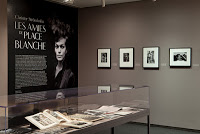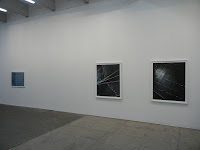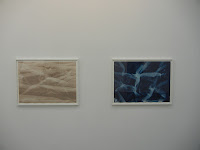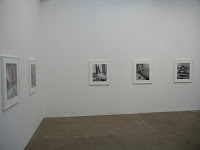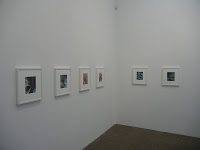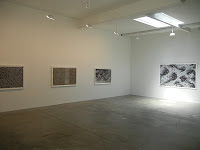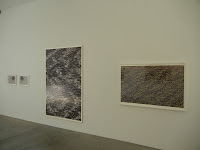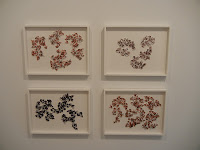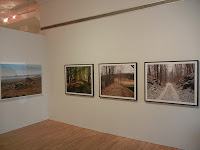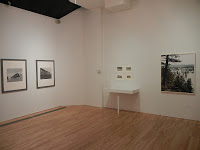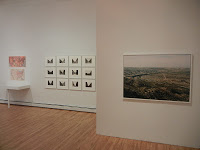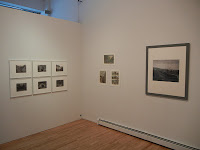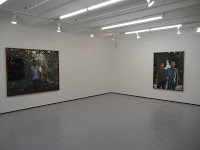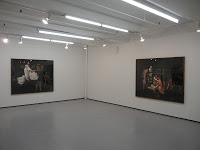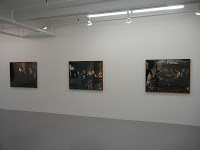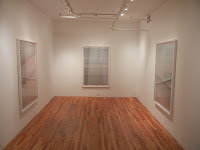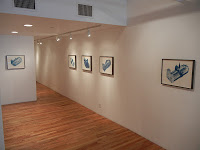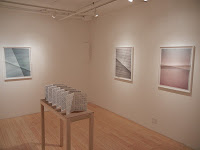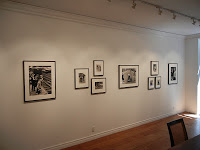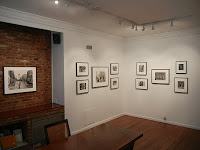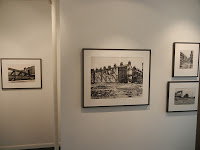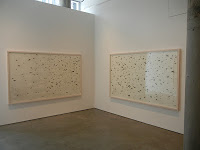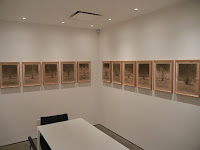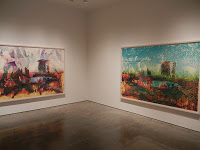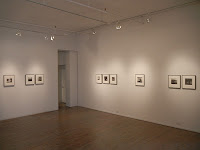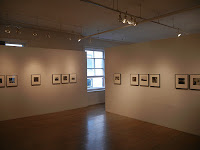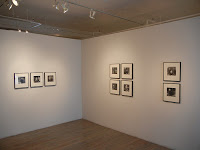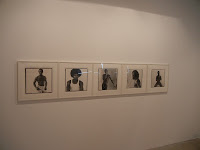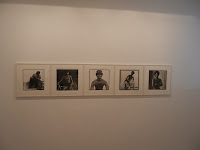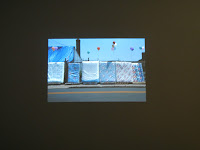 JTF (just the facts): A total of 229 color photographs, displayed as a continuous slideshow (roughly 30 minutes long) in the darkened main gallery space. These images were made between 2001 and 2010. The show also includes 25 color photographs (and a map) of Strauss’ installation of the work under the I-95 interstate highway in Philadelphia; these prints are unframed and tacked to the wall in a cluster in the front gallery. A single finished print, framed in white and unmatted, is hung on the wall outside the slideshow; it is sized 18×27 and is uneditioned. (Installation shots at right.)
JTF (just the facts): A total of 229 color photographs, displayed as a continuous slideshow (roughly 30 minutes long) in the darkened main gallery space. These images were made between 2001 and 2010. The show also includes 25 color photographs (and a map) of Strauss’ installation of the work under the I-95 interstate highway in Philadelphia; these prints are unframed and tacked to the wall in a cluster in the front gallery. A single finished print, framed in white and unmatted, is hung on the wall outside the slideshow; it is sized 18×27 and is uneditioned. (Installation shots at right.)
Comments/Context: In this age of increasingly short attention spans, few contemporary photographers commit themselves to sustaining a single artistic project for an entire decade. What is lost in this manic flitting from one thing to the next is the steady accumulation of ideas that only becomes evident when we slow down and take a long view. Change, in the broadest sense, nearly always happens in increments too small to notice at the time and patterns don’t emerge until we can stop for a moment to look back and see the repetitions. The power of the long term project is in its ability to provide rich, layered persepctive and to get much further into the hidden details than a cursory examination normally allows.
Strauss’ portraits of friends, neighbors and strangers cover an emotional landscape from weariness to proud defiance and from anxiety to everyday joy. In many cases, her pictures are startlingly direct and quietly poignant: a girl’s evil looking puffy black eye, a woman holding a dead bird, a man with a pistol, a boy exuberantly flipping upside down onto a pile of mattresses in the street. In others, tiny details anchor a face (a squiggling curl of hair, pierced ears that have been stripped, missing front teeth, a hairnet) while scars (suicide, c section, heart surgery), tattoos, severed digits and bloody injuries provide other forms of personal identification.
Like Walker Evans before her, Strauss also has a fondness for vernacular American signage, particularly the one liner which has been made unintentionally ironic by its surroundings or condition. There’s Let’s Roll! next door to the depression clinic, POWER in bright lights with the P burned out, Satisfaction Guaranteed reduced to a ghost of itself, and the crumpled arches of a McDonalds sign. If the pessimism of the emotional landscape of the times has somehow been forgotten, Keep the fuck out! and This is your warning help to bring back the simmering harshness with heavy immediacy. Other pictures delve into more formal architectural geometries and Eggleston-like studies of color. Ice covered stairs flank a blue wall, a house is split down the middle into pink and white halves, and red horizontal stripes cover adjacent buildings. Colors pop in images of an electric green ceiling, red carpeted stairs, and the competing dress patterns in a butcher shop. A pile of pillows and a wilted corsage become elegant still lifes. Part of what makes Strauss’ work so strong is its familiar looseness; compared with other successful photography documenting the same period (Soth, Epstein, Ulrich etc.), her images are grittier and more immediate, even when they are highly structured.
For an otherwise excellent body of work, my one complaint is that the slideshow format of this exhibit severely undermines its ultimate impact. The images click by, making it impossible to return to them later to savor their details or to orient them in a chronological progression. While I liked the sense of thematic variation and repetition that was apparent, the overall effect of the darkened room experience was underwhelming and vaguely dissatisfying. This is a big gallery space with lots of nooks and crannies; it could have easily held a decent sample of the project, especially if the prints were double hung, gridded, or otherwise clustered. Or maybe the slideshow should have run in the smaller far back room as an adjunct to a more formal presentation. While I watched the show, most people came in, sat down for a dozen slides or so, and then gave up. If the gallery had been filled with prints (instead of feeling largely empty), the experience of the project would likely have been more fully representative of the high quality of the work.
All in, this is a remarkably strong and consistent photographic project, with plenty of subject matter and stylistic breadth. Across the years and along the way, Zoe Strauss has refined her talents and honed her craft, emerging what likely seems like a lifetime later with a sharp and original eye. Based on the merits of the work alone, this show easily deserves a higher rating. But given its suboptimal installation, I was left wishing for a different and more triumphant summation.
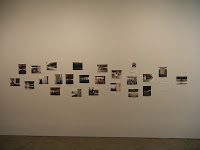 Collector’s POV: The main slideshow on display here is not for sale. Strauss’ prints apparently come in three sizes: roughly 8×12, 12×18, and 18×27, all uneditioned. The largest size (like the one framed print on view) is priced at $3600; I didn’t get the details for the other smaller sizes. Strauss’ work has not yet reached the secondary markets with any regularity, so gallery retail remains the best option for those collectors interested in following up.
Collector’s POV: The main slideshow on display here is not for sale. Strauss’ prints apparently come in three sizes: roughly 8×12, 12×18, and 18×27, all uneditioned. The largest size (like the one framed print on view) is priced at $3600; I didn’t get the details for the other smaller sizes. Strauss’ work has not yet reached the secondary markets with any regularity, so gallery retail remains the best option for those collectors interested in following up.
Rating: * (one star) GOOD (rating system described here)
Transit Hub:
- Artist site (here)
- Exhibit/Catalog: Philadelphia Museum of Art, 2012 (here and here)
- Reviews: NY Times (here), Bloomberg (here)
